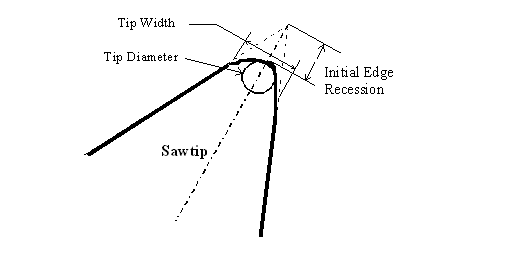 Loading... Please wait...
Loading... Please wait...(800) 346-8274
Free Ground Shipping on Orders over $150!
Over 23,000 Items Discounts up to 40% off Retail
Forintek Research Paper
Our Newsletter
- Home
- Media
- Magazine Articles
- Forintek Research Paper
Forintek Research Paper
|
“New Ceramic Tipped Saws Increase Wear life” By Darrell Wong, Research Scientist Sawtips and their durability play a key role in production throughput and recovery of sawmill as well as sawing deviation and target size. The reason is that they are in direct contact with the wood and consequently have a direct effect on cutting. Since tooth tolerances of a 0.001-inch and 0.1-degree are critical to saw performance, excessive sawtip wear can dramatically degrade sawing performance and increase horsepower requirements. Many new grades of Tungsten Carbides as well as new materials such as Cermics are commercially available that could improve the durability of sawtips and improve sawing performance. Forintek identified one of these materials, Cermets, that showed significantly improved durability compared to tungsten carbide when cutting western red cedar. Cermets are a class of tool material that have ceramic particles bonded with metal - "cer" for ceramic and "met" for metal. The new generation of Cermets are solid compositions such titanium carbide (TiC), titanium nitride (TiN) and others. These materials are very hard when compared to standard tungsten carbide tool materials and as a result, have a much higher durability in specific applications. The composition and manufacturing of these new generation of Cermets give them toughness for more extreme applications, such as those experienced in sawmilling, that were not possible previously. The premise of this test was that if the Cermet could survive a sawmilling application, then they could find wide application in wood processing. It is important to emphasize that Cermets have different properties than tungsten carbide and, as a result, may require unique cutting speed and bite settings as well as a different grinding procedure compare to tungsten Carbide or any other tool material. One particular grade of Cermet manufactured by Kennametal Inc. (KT-195) was compared to a standard tungsten carbide (K3030C). Measurements of saw tip wear were compared over 20,000 lineal feet of cutting western red cedar. The material loss at the tip was determined by measuring the average tip recession. The sharpness of the sawtip was determined by measuring the diameter of the tip. The portion of the tip affected by wear was determined by measuring the wear width. All measurements were made relative to the initial sharpened state. The most significant wear advantage of the Cermet was demonstrated in the sawtip recession, the key wear measurement. The magnitude and rate (slope of the graph) of tip recession of the Cermet was significantly lower than the Tungsten Carbide with the recession of the Cermet approximately half that of Tungsten Carbide. After 20000 feet of cutting, the Tungsten Carbide had worn out but the Cermet remained in a useable condition. The summary table of the recession, width and diameter change of the two tip materials further emphasize the wear advantage of the Cermet. The saw tip diameter change of the Cermet shows that it remains sharper than the Tungsten Carbide. In terms of wear and sharpness, Cermet conclusively has an advantage when sawing western red cedar.
The more important question for many companies is what is the economic benefit? This requires a more difficult to determine factor, tool life. Tool life can be a somewhat elusive factor because there are many ways to determine it and it is also application dependant. Cermets are too new to woodworking for tool life to be known with confidence. It is possible to estimate the relative tool life of Cermet by making several key assumptions. The first assumption is that the end-of-life characteristics of Cermet are similar to that of Tungsten Carbide. The second assumption is that the Cermet wear trends will continue until the end-of-life criteria are achieved. Using the Tungsten Carbide as the baseline, the Table shows the cutting distances at which the Cermet achieved the same recession, diameter and width change a comparison of which allows a relative wear factor to be estimated. The Cermet is projected to have a wear advantage of 1.7 to 4 times over the Tungsten Carbide. A more precise estimate would require application specific testing.
Depending on the saw design, it estimated that Cermet saws would cost up to twice that of a comparable Tungsten Carbide saw. This indicates that the cost per foot of material cut by Cermet saws could range from 10% more to 75% less than Tungsten Carbide saws. When the benefit of reduced downtime and maintenance are also factored, the advantage of Cermet warrants a closer look. |
||||||||||||||||||||||||||||||||||||||||||||||||||||||








